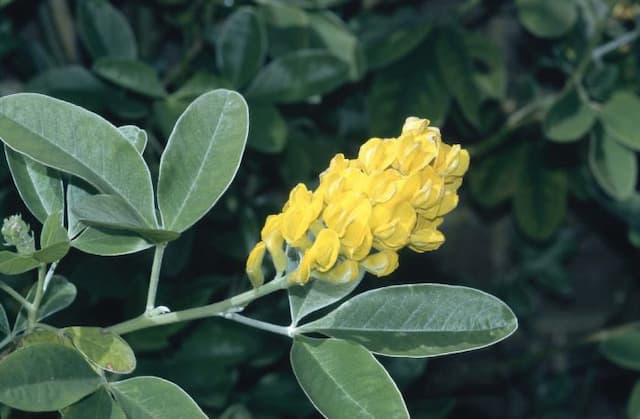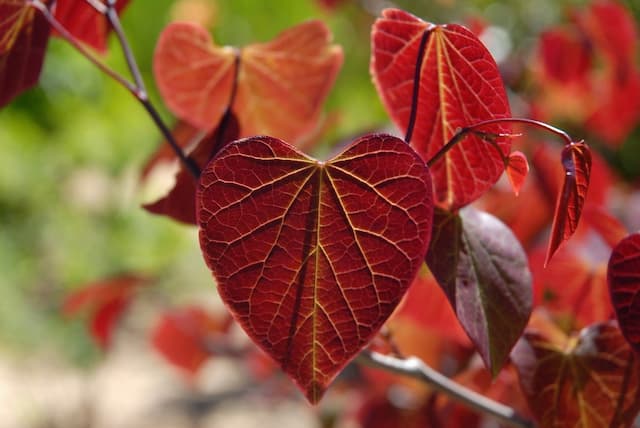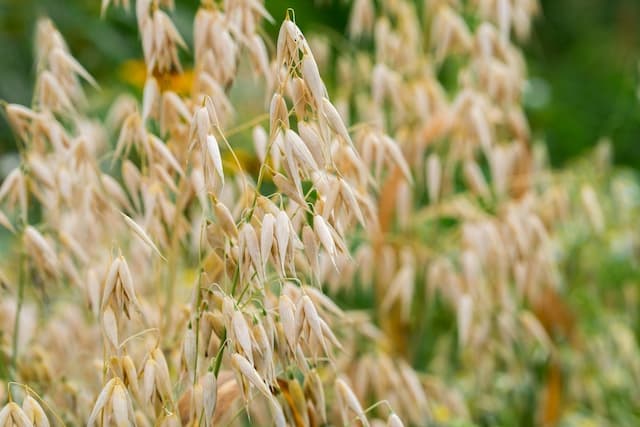Cockspur coral tree Erythrina crista-galli

ABOUT
The plant known as the cockspur coral tree is renowned for its striking appearance, characterized by a vivid display of deep red or crimson flowers that resemble the outstretched claw of a rooster, thus inspiring its common name. These showy blossoms form dense clusters at the tips of the branches, providing a vibrant spectacle that is typically seen during the summer months. The flowers of the cockspur coral tree are not only notable for their color but also for their unique shape. Each individual blossom is tubular and slightly curved, reminiscent of a rooster's spur, with the petals flaring out elegantly at the mouth of the tube. Complementing its ornate flowers, the plant has a lush, green canopy composed of broad leaves that are trifoliate, meaning each leaf is split into three distinct leaflets. These leaflets are oval-shaped with pointed tips and are arranged in an alternating pattern along the stems. Despite its beauty, when not in bloom, the cockspur coral tree reveals a different aspect of its character through its trunk and branches. The bark is typically rough and hosts thorns that can be rather formidable, adding a protective element to the otherwise inviting plant. The branches tend to spread widely, creating an umbrella-like canopy that is interspersed with the sharp thorns. In essence, the cockspur coral tree is a marriage of beauty and defense, displaying a striking contrast between the aggressive thorns and the delicate, exotic blooms that draw admirers from near and far.
About this plant
 Names
NamesFamily
Fabaceae
Synonyms
Cockspur Coral Tree, Cry-Baby Tree, Ceibo, Seibo, Coral Tree, Brazilian Coral Tree
Common names
Corallodendron crista-galli, Erythrina crista, Erythrina crista-galli var. hasskarlii, Erythrina fasciculata, Erythrina inermis, Erythrina laurifolia, Erythrina pulcherrima, Erythrina speciosa, Erythrina tomentosa, Micropteryx crista-galli.
 Characteristics
CharacteristicsLife cycle
Perennials
Foliage type
Deciduous
Color of leaves
Green
Flower color
Red
Height
15-25 feet [4.5-7.6 meters]
Spread
10-15 feet [3-4.5 meters]
Plant type
Tree
Hardiness zones
9
Native area
South America
Benefits
 General Benefits
General Benefits- Ornamental value: Erythrina crista-galli, commonly known as Cockspur Coral Tree, is widely used as an ornamental plant due to its striking deep red flowers and unique coral-like appearance.
- Habitat for wildlife: Its blooms provide nectar for hummingbirds and butterflies, offering an important food source for these pollinators.
- Shade provider: With its broad canopy, the tree can offer significant shade in gardens and parks, which helps in reducing local temperature and providing a cooler environment.
- Soil improvement: The tree can help in binding the soil, thus preventing erosion and improving soil quality with its leaf litter.
- Cultural significance: In some cultures, the tree is considered symbolic and is used in various ceremonies and traditional practices.
- Drought resistance: Adapted to thrive in drought-prone areas, it requires minimal water once established, making it suitable for xeriscaping and arid landscaping designs.
 Medical Properties
Medical Properties- Anti-inflammatory: Erythrina crista-galli extracts may have properties that help reduce inflammation.
- Anxiolytic: Some studies suggest that components of the plant might have anxiety-reducing effects.
- Antimicrobial: Extracts from the plant have shown potential in inhibiting the growth of bacteria and other microorganisms.
- Neuroprotective: There are indications that the plant may have properties that protect nerve cells.
- Analgesic: Traditional use of the plant suggests it may have pain-relieving effects.
 Air-purifying Qualities
Air-purifying QualitiesThis plant is not specifically known for air purifying qualities.
 Other Uses
Other Uses- Erythrina crista-galli, commonly known as the cockspur coral tree, has been used historically in tanning for its bark, which contains tannins that can treat leather.
- In some regions, this tree's thorny branches are utilized to create natural fencing that deters animals and unauthorized entry into private lands.
- The wood of the cockspur coral tree is light and easily worked, making it suitable for crafting lightweight structures or utensils in rural communities.
- The tree's bright red flowers are used in decorative arrangements and cultural ceremonies to signify various symbolic meanings depending on the local traditions.
- Farmers sometimes plant the cockspur coral tree as a shade provider in coffee plantations due to its broad canopy and ability to improve the microclimate for undergrowth crops.
- The flowers of the cockspur coral tree are used to make natural dyes for textiles, providing a specific shade of red that is much sought after in local handicrafts.
- In areas prone to soil erosion, the deep root system of the cockspur coral tree is planted to help stabilize soil and prevent landslide incidents.
- Some cultures use the seeds and flowers of the cockspur coral tree in traditional games and as counting tools, attributing educational play to the plant's parts.
- The robust stems of the cockspur coral tree play a role in stream and riverbank stabilization, where they help to firm up banks and reduce erosion from water flow.
- In traditional boat-making communities, the lightweight wood of the cockspur coral tree may be used for constructing certain types of non-structural components, like oars or decorative elements in boats.
Interesting Facts
 Feng Shui
Feng ShuiThe Cockspur Coral Tree is not used in Feng Shui practice.
 Zodiac Sign Compitability
Zodiac Sign CompitabilityThe Cockspur Coral Tree is not used in astrology practice.
 Plant Symbolism
Plant Symbolism- National Emblem: Erythrina crista-galli, commonly known as the Cockspur Coral Tree, is the national flower of Argentina and Uruguay, symbolizing the pride and cultural identity of these nations.
- Resilience: Known for its hardiness and ability to thrive in different environments, the Cockspur Coral Tree represents resilience and the capacity to withstand adversity.
- Protection: With its thorny branches, the tree is associated with protection and the concept of safeguarding oneself or one's loved ones from harm.
- Beauty in bloom: The Cockspur Coral Tree's stunning red flowers symbolize beauty and the joy of life, especially when they bloom vividly against the green backdrop of its foliage.
- Fertility: In some cultures, the prolific seed pods and striking flowers are seen as symbols of fertility and abundance.
 Water
WaterThe cockspur coral tree (Erythrina crista-galli) should be watered regularly, especially during its growing season in spring and summer. It prefers consistently moist soil but does not tolerate waterlogging; ensure good drainage is in place. During the active growth period, you may need to water the plant once a week with 1-2 gallons, depending on the weather conditions and soil's moisture level. In winter, reduce watering to once every two to three weeks as the plant enters dormancy. Always check the top inch of soil for dryness before adding more water.
 Light
LightThe cockspur coral tree thrives best in full sunlight, so it should be positioned in a spot where it can receive at least six hours of direct sunlight daily. An ideal location would be in an unobstructed area facing south or west that gets plenty of afternoon sun to ensure it receives the amount of light it needs to flourish.
 Temperature
TemperatureThe cockspur coral tree enjoys warm temperatures and does best when the climate is between 60 and 80 degrees Fahrenheit. Ensure that it is not exposed to temperatures below 30 degrees Fahrenheit as frost can heavily damage the plant. The ideal temperature range is key for optimal growth and blooming.
 Pruning
PruningPruning the cockspur coral tree is essential to maintain its shape and support vigorous growth. It's best to prune during late winter or early spring before new growth begins. Remove dead or damaged branches and shape as desired, but avoid heavy pruning as the tree can be sensitive. This activity should be done annually to ensure the health and aesthetics of the tree.
 Cleaning
CleaningAs needed
 Soil
SoilThe Cockspur Coral Tree prefers well-draining soil amended with organic matter, such as peat, compost, or well-rotted manure. The best soil mix would include equal parts of loam, sand, and organic compost. The pH level that the Cockspur Coral Tree requires ranges from neutral to slightly acidic, ideally between 6.5 and 7.5.
 Repotting
RepottingThe Cockspur Coral Tree should be repotted approximately every two to three years. Younger trees or those growing in small containers may need repotting more frequently. Repotting is best done in the spring before new growth begins.
 Humidity & Misting
Humidity & MistingThe Cockspur Coral Tree thrives best in moderate to high humidity levels. If grown in an environment where humidity tends to be low, it is beneficial to provide additional moisture through regular misting or by using a humidifier.
 Suitable locations
Suitable locationsIndoor
Place in a bright room and water moderately.
Outdoor
Full sun, protect from frost, well-drained soil.
Hardiness zone
9-11 USDA
 Life cycle
Life cycleErythrina crista-galli, commonly known as the Cockspur Coral Tree, starts its life as a seed that germinates in warm, moist soil, with successful sprouting typically occurring during spring or early summer. The seedling stage is marked by the emergence of the primary leaves, and the young plant begins to develop a robust root system. As it enters the vegetative stage, the plant develops a woody stem and a spreading canopy of trifoliate leaves, and it can rapidly grow to reach its mature height. During the flowering stage, which occurs in summer, the Cockspur Coral Tree produces vibrant red, coral-like flowers that are rich in nectar, attracting pollinators such as bees and birds. Following pollination, the plant produces legume-like seed pods that mature and eventually release seeds, thus completing the reproductive cycle. In temperate climates, the plant may lose its leaves during the winter, entering a dormant phase, before resuming growth in the spring.
 Propogation
PropogationPropogation time
Spring to summer
The most popular method of propagation for the Cockspur Coral Tree (Erythrina crista-galli) is through seed. The best time to sow the seeds is in late winter or early spring, when the temperature begins to rise, to give the seedlings a full growing season. The seeds have a tough coat, so it's recommended to scarify them by gently nicking or sanding the outer layer without damaging the inner part, or by soaking them in water for 24 hours to improve germination rates. Once prepared, the seeds can be sown in a well-draining seed starting mix, placed about an inch deep (roughly 2.5 cm), and kept moist but not waterlogged. Seedlings usually emerge within a few weeks and can be transplanted into individual pots once they have a couple of sets of true leaves, continuing to ensure they have appropriate light and water to promote healthy growth.









